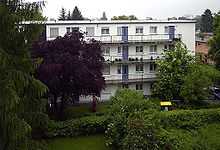New Frankfurt
.jpg)
New Frankfurt (in German, Neues Frankfurt) was an affordable public housing program in Frankfurt started in 1925 and completed in 1930.[1] It was also the name of the accompanying magazine that was published from 1926 to 1931 dedicated to international tendencies in architecture, the renewal of art, housing and education.
History
The project was initiated by Frankfurt's mayor Ludwig Landmann, who hired the architect Ernst May as a general manager of many communal departments. Renowned architects like Max Cetto, Martin Elsaesser, Walter Gropius, Ferdinand Kramer, Adolf Meyer, Bruno Taut, Margarete Schütte-Lihotzky and Mart Stam worked in Frankfurt.
Under May 12,000 apartments were built, 2,000 more than planned. The buildings not only met the basic needs of housing, they set standards for urban development and design but break also with traditional house building. All apartments and mansions were equipped with a Frankfurt kitchen. Catherine Bauer Wurster visited the buildings in 1930 and was inspired by the work of May.[2]
Nazi critics denigrated the project as “Mr May's small Soviet industry”[3] and Joseph Goebbels called Ernst May for propaganda reasons the “Lenin of German architecture”, even if it is told that he loved the modern architecture. The Nazis stopped all construction activities and presented the estates as an own new Nationalsocialist architecture to foreign visitors. Most employees of the project left Germany after 1933, some of them followed Ernst May to the Sowjetunion, which invited teams of famous architects, like Le Corbusier and from the Bauhaus to work there.
After some demolitions of houses designed by Mart Stam and protest, the estates were declared protected landmarks in the late 1970s.
One two-storey terrace house was renovated and restored into the standard of 1928 by the Ernst-May-Society, it is called Ernst May House and is a museum today. The reconstruction was fellowed by buildings researchers and architectural historians.
Selected projects

- Villa May, Frankfurt am Main, 1925
- Villa Elsaesser, Frankfurt am Main, 1925–1926
- Estate Höhenblick, Frankfurt am Main, 1926–1927
- Estate Bruchfeldstraße (Zickzackhausen), Frankfurt am Main, 1926–1927
- Estate Riederwald, Frankfurt am Main, 1926–1927
- Estate Praunheim, Frankfurt am Main, 1926–1928
- Estate Römerstadt, Frankfurt am Main, 1926–1928
- Estate Bornheimer Hang, Frankfurt am Main, 1926–1930
- Estate Heimatsiedlung, Frankfurt am Main, 1927–1934
- Estate Hellerhof, Frankfurt am Main, 1929–1932
- Röderberg school, Frankfurt am Main, 1929–1930
- Estate Westhausen, Frankfurt am Main, 1929–1931
- House in Dornbusch, Frankfurt an Main, 1927–1931
Literature
- Susan R. Henderson: Building Culture: Ernst May and the New Frankfurt Initiative, 1926-1931, Peter Lang, 2013
- Barbara Miller Lane: Architecture and Politics in Germany 1918-1945, Harvard University Press, 1968, rev. ed. 1985
References
- ↑ MOMA: "The Frankfurt Kitchen". retrieved 11 April 2013
- ↑ Leill Levine: Frank Lloyd Wright: Modern Architecture: Being the Kahn Lectures for 1930, 2008 pg.ix
- ↑ Fassil Demissie: Colonial Architecture and Urbanism in Africa, 2011 pg.374
External links
| Wikimedia Commons has media related to New Frankfurt. |
- https://www.frankfurt.de/sixcms/detail.php?id=317578&_ffmpar[_id_inhalt]=5021021 Informations on frankfurt.de
- Website of the Ernst-May-Society